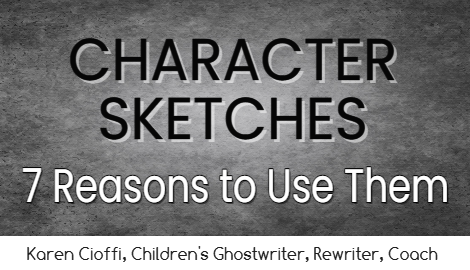Characters are an intricate part of fiction writing. They weave together the narrative. They are also the heart and soul of any story, driving the plot forward, evoking emotions, and engaging readers.
Crafting compelling characters takes skill and writing tools. One essential tool in an author's arsenal is the character sketch.
According to Mary Kole, “In simple terms, a character sketch is a detailed description of a character that outlines the character's qualities, objectives, motivations, needs, wounds, misbeliefs and flaws, backstory, and more.”
Character sketches are invaluable blueprints that give writers a deep understanding of their characters, allowing them to breathe life into their creations.
So, let’s jump into why creating character sketches is vital in the world of fiction writing.
1. Serves as a Roadmap
First and foremost, character sketches serve as a roadmap. Just as architects sketch blueprints before constructing a building, you should sketch out characters before embarking on their journey.
These sketches outline crucial character details such as physical appearance, personality traits, moral code, motivations, fears, desires, and what they believe is the worst that can happen to them.
The best way to create a character sketch is to ask your character penetrating questions. By fleshing out these questions, you will gain a clear vision of who your characters are and create well-rounded characters.
Even simple sketches will give you an edge in plotting out your story.
2. Helps Write Convincingly
Character sketches allow you to focus and write convincingly. You’ll know what your character will do in any given situation.
These sketches will also allow you to know how each character will interact with the other characters in the story.
No second guessing. No having to remember. This knowledge will make writing easier and foster writing confidence.
3. Provides Authenticity and Consistency
Character sketches allow for authenticity and consistency in storytelling.
They help avoid static characters. While the characters evolve and grow throughout the course of a story, their core traits remain constant.
So, if Lucas is hot-tempered, he’ll be hot-tempered throughout the story. He may learn to control it as he grows, but it will be a constant underlying characteristic.
By carefully outlining these traits in character sketches, you’ll ensure that your characters remain true to themselves, maintaining believability and resonating with readers.
Consistency is key to crafting a compelling narrative, whether a character is a hero or villain.
4. Promotes Creativity
Character sketches serve as a springboard for creativity. As you delve into the intricacies of your characters' backgrounds and personalities, you will often uncover unexpected layers and complexities.
These revelations can spark new ideas and directions for the story, enriching the narrative and keeping readers engaged.
Character sketches provide you with a playground to explore. This exploration allows you to delve into human nature, which helps you create authentic and relatable characters.
5. Fosters Empathy and Understanding
Knowing your characters inside and out will help create the reader’s connection. Character sketches will help foster empathy and understanding. To develop well-rounded characters, you need to dive into human experiences. Explore your characters’ triumphs and tribulations that shape their lives.
Through the process of creating character sketches, you will develop a deep empathy for your characters. You’ll understand their hopes, fears, and struggles. This empathy translates into richer storytelling. And your empathy for and understanding of the characters will help readers to make the same connections.
6. Helps in Plot Development
Characters are not passive entities; they drive the narrative forward through their actions, reactions, and decisions.
By understanding your characters' motivations and goals, you can craft plotlines that resonate with their characters' journeys, leading to more organic and compelling storytelling.
Character sketches serve as a guiding light and ensures that the plot remains tightly woven around the characters' arcs.
7. Connects You and Your Readers
Characters are the bridge between you and your audience. This connection allows the readers to explore and become invested in the world that you’ve built.
Creating vivid and memorable characters invites readers to go on that journey with you, forging a deep and lasting connection.
Character sketches provide readers with insight into the inner workings of the characters' minds, enriching the reading experience.
Summing It Up
Whether they’re full-blown character sketches or simple ones that you can add on to, this writing tool provides you with a roadmap for navigating the narrative, fostering authenticity, consistency, and creativity.
Through the process of creating character sketches, you develop a connection with your characters, fostering empathy for them. This process will lead to richer storytelling and give it depth.
Character sketches serve as your story’s foundation.

I’m a working children’s ghostwriter, rewriter, editor, and coach. I can help turn your story into a book you’ll be proud to be the author of, one that’s publishable and marketable.
OTHER HELP I OFFER:
HOW TO WRITE A CHILDREN’S FICTION BOOK
A DIY book to help you write your own children’s book.
PICTURE BOOK AND CHAPTER BOOK COACHING
Four to ten-week coaching programs.
WRITERS ON THE MOVE PRESS.
Self-publishing help for children’s authors.
You can contact me at: kcioffiventrice@gmail.com. Or give me a call at 347—834—6700. (Please leave a message- I’ll get back to you as soon as I can.)

